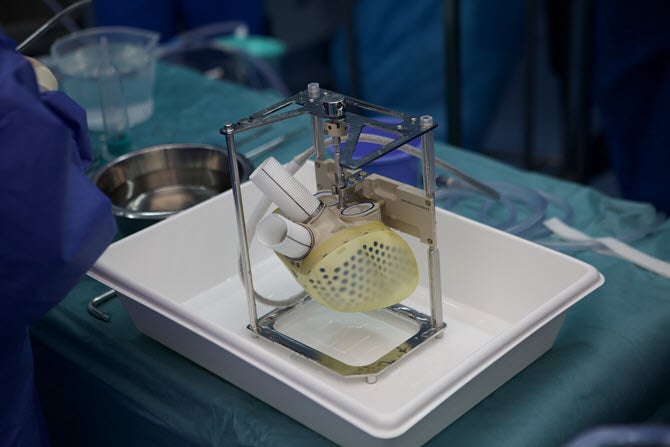UMC Utrecht the first hospital in the Netherlands to implant a completely artificial heart
UMC Utrecht the first hospital in the Netherlands to implant a completely artificial heart

In early November, a patient with severe heart failure was implanted with a total artificial heart at the UMC Utrecht for the first time in The Netherlands. The artificial heart replaces and takes over the function of the entire heart. This innovative artificial heart provides an improved pump function and blood supply, alleviating symptoms for the patient. The implantation of the artificial heart was successful. The patient is doing well and was discharged from the Intensive Care Unit within two days after the procedure.
There is a great shortage of donor hearts in The Netherlands: around 120 patients are on the waiting list for a donor heart every year. The innovative artificial heart offers a solution for patients whose critical condition prevents them from waiting for a heart transplant. The UMC Utrecht has been selected as a top center by French manufacturer CARMAT SA to be the first in the Netherlands to implant the artificial heart in a patient with very severe heart failure. The artificial heart replaces the patient’s diseased heart and takes over the full function of the heart. The artificial heart is attached to the atria of the heart, the aorta and the pulmonary artery. The anatomical shape of the artificial heart is the same as that of the adult human heart.
Successful implantation
The implantation of the artificial heart in the patient was successful and the first impression is promising, says Faiz Ramjankhan, cardiothoracic surgeon at UMC Utrecht under whose direction the surgery was performed. “It was an exciting operation that took a lot of preparation. With our team, we have been working since 2017 to enable the implantation of an artificial heart. During the months prior to the procedure, our team participated during several months in specific training to perform this operation. We are proud to be one of the first centers to be part of the study investigating the durability of this new artificial heart technology. If this treatment proves to be sufficiently durable, it will allow us to treat many more patients who currently have no treatment options."
Artificial heart and external controller
The innovative artificial heart is equipped with pumps, four biological valves, sensors, electronics and integrated software. Ramjankhan says, “The advantage of this artificial heart is that the outside is made of polyurethane and the inside is lined with biological material from bovine pericardium. The blood is pumped by a membrane to the aorta and pulmonary artery. As a result, the blood only comes into contact with mainly biological material.” The artificial heart is connected to a cable that exits through the patient’s abdominal wall. This cable is connected to a controller and a set of four batteries that the patient always carries in a shoulder bag. The patient can move freely with this shoulder bag weighing approximately three kilos.
Very severe heart failure
The first artificial heart was implanted in the Netherlands in early November in a 54-year-old man with severe biventricular heart failure. Both the left and right ventricles were not functioning properly, leading to symptoms such as fatigue, fluid retention and shortness of breath, both at rest and on exertion. A final possible treatment was a heart transplant in the future, but waiting times are too long for this patient and would probably result in death. The innovative artificial heart offers a solution for patients who, due to their critical situation, cannot wait for a heart transplant. There is still a long waiting list for that, because there is a great shortage of donor hearts.
Improved pump function and blood supply
The new artificial heart provides the patient with an improved pump function and blood supply, resulting in fewer complaints. Linda van Laake, cardiologist and responsible for patient selection, says, “Through the innovative pumps, valves and sensors, the artificial heart adapts to the patient. The human heart pumps an average of 4 to 5 liters of blood per minute at rest; this increases with exertion. The artificial heart will also start pumping faster upon exertion. A promising development is that the artificial heart does not require the use of heavy drugs to suppress the immune system. This is better for the resistance and reduces the risk of infections. As the patient’s recovery progresses, activities such as walking and cycling can be resumed.”
Safety and efficacy study
Naturally, this new artificial heart will be followed by medical scientific research to investigate its safety, efficacy and durability in patients with severe heart failure. There is no full reimbursement from health insurance companies (yet).
The total artificial heart
- The total artificial heart replaces a patient’s entire heart.
- The artificial heart weighs about 1000 grams and a diseased heart weighs about 500 to 600 grams.
- The innovative artificial heart is equipped with pumps, four biological valves, sensors, electronics and integrated software.
- The artificial heart resembles a natural heart and also has similar properties. It consists of two ventricles and four biological valves.
- The artificial heart is made of the synthetic polyurethane and the inside is lined with biological material (bovine pericardium).
External box
- The artificial heart is connected to an 8-mm diameter cable that exits through the patient’s abdominal wall.
- The cable is linked to an external box carried by the patient. This box is connected to a controller and a set of four batteries that the patient always carries in a shoulder bag.
- The patient replaces the set of four batteries two to three times a day.
- The shoulder bag weighs about three kilos and this shoulder bag or backpack allows a patient to move around freely.
For whom?
The artificial heart is currently only available on a very limited basis and is intended for patients with very severe heart failure (end-stage heart failure) within the context of scientific research.

